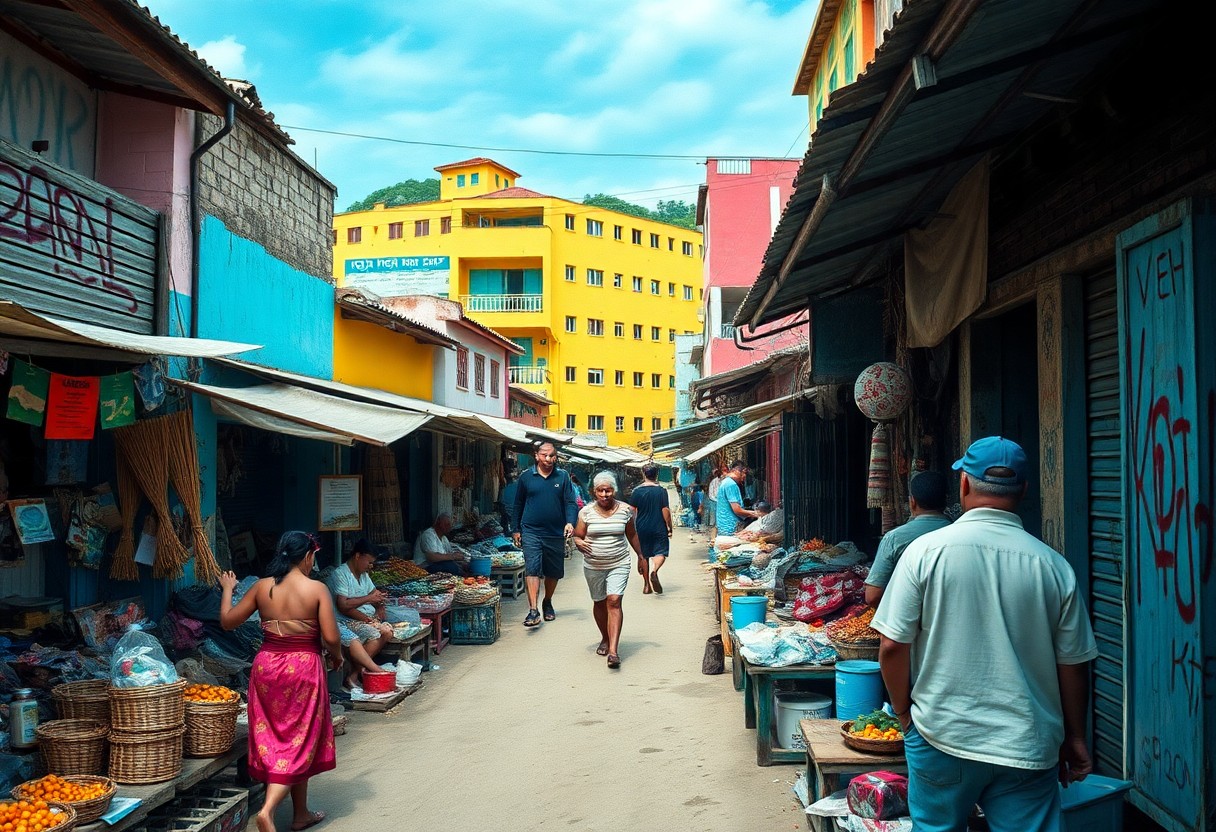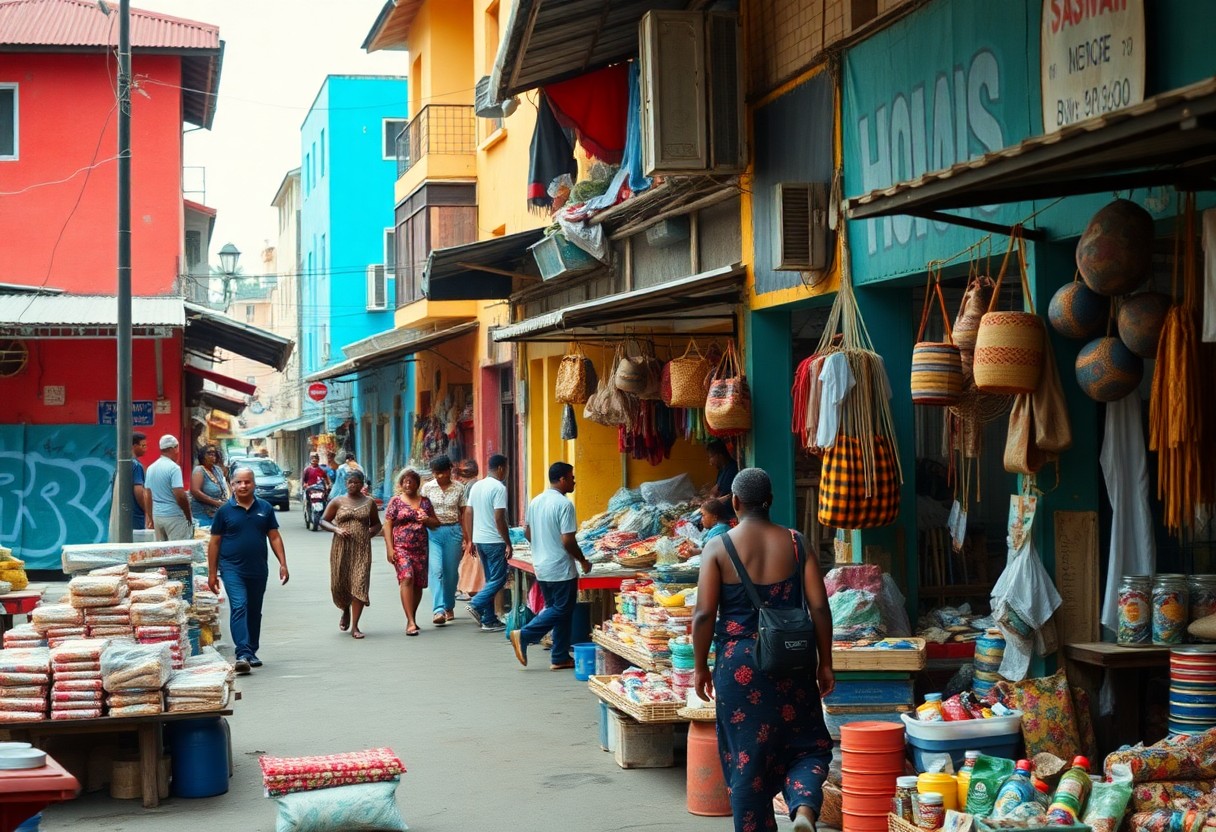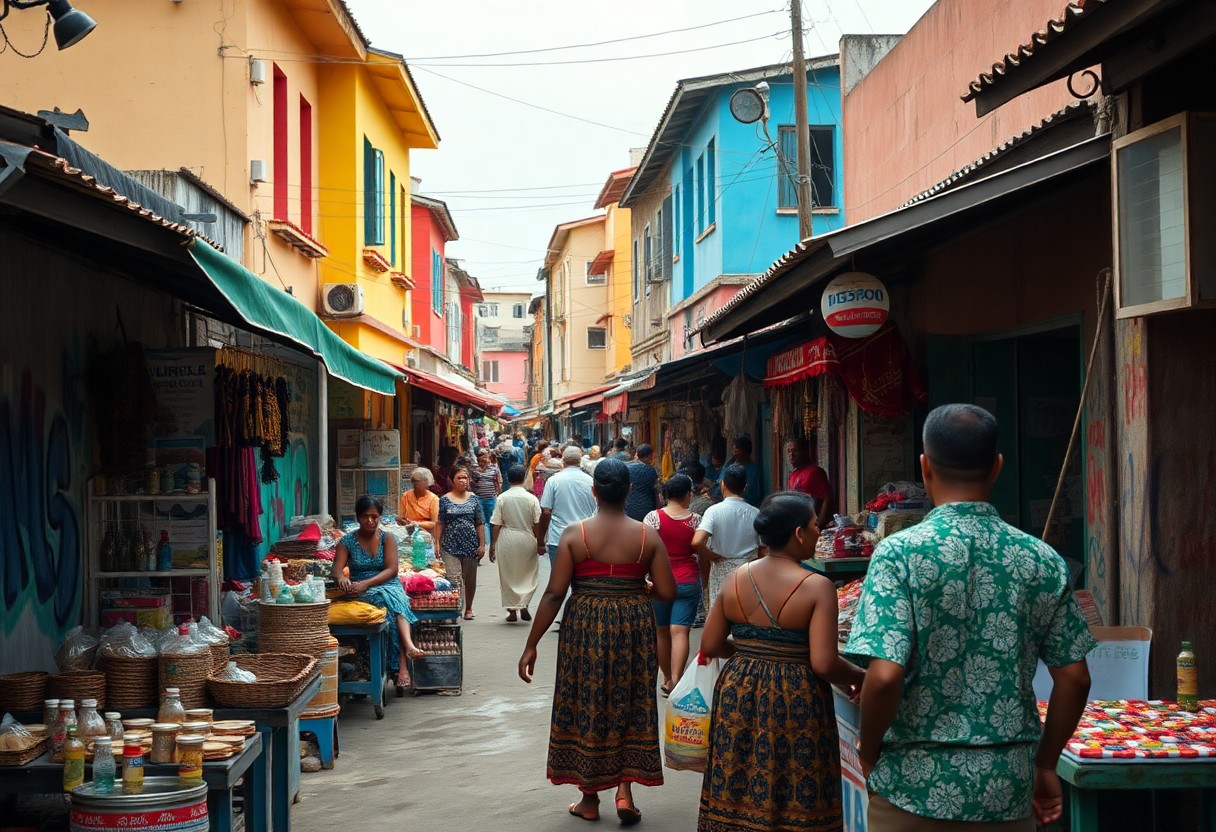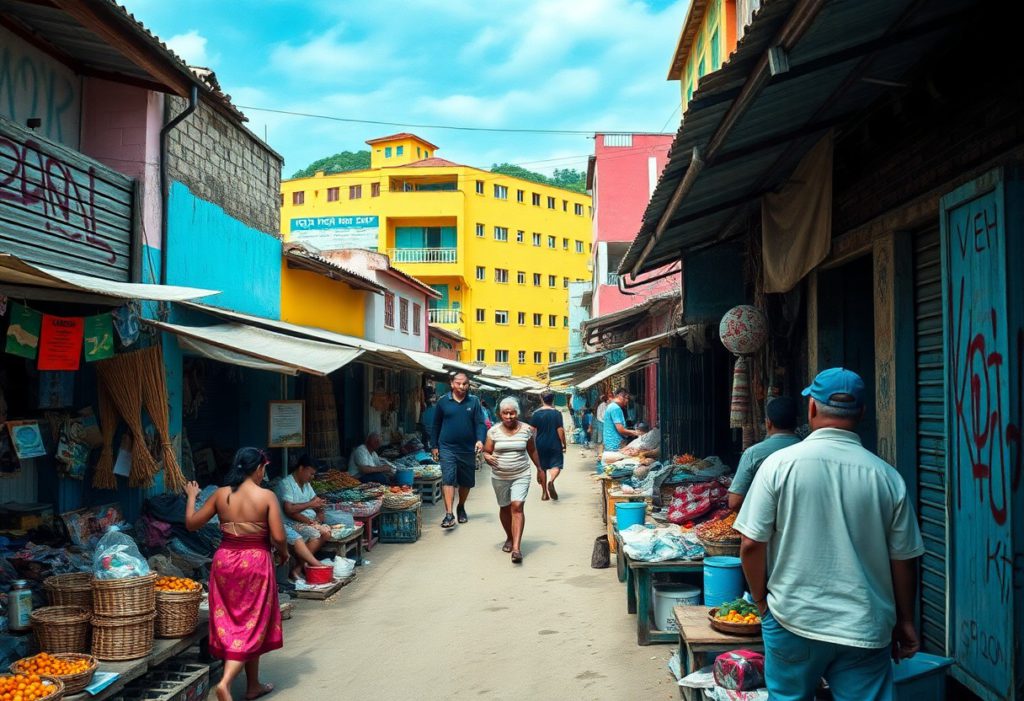Belize is navigating a complex economic landscape that challenges simplistic narratives about poverty. The nation faces significant economic hurdles yet simultaneously possesses remarkable potential for growth and innovation. By examining the intricate details of Belize’s economic environment, you will gain a comprehensive perspective on the development challenges contrasted with emerging opportunities. The economic health of Belize is largely influenced by critical sectors such as tourism, agriculture, and offshore services, which collectively form a dynamic economic ecosystem. Exploring these interconnected elements will uncover essential insights into Belize's economic future and the creative strategies being implemented to foster increased prosperity.
Delving into the Metrics of Poverty: Key Economic Indicators
To fully appreciate Belize's economic landscape, it is vital to understand how poverty is measured and interpreted. Economic indicators provide a detailed view of a nation's financial health, allowing for an assessment of its economic status from multiple perspectives. These essential metrics are crucial for analyzing the multifaceted economic challenges faced by countries like Belize, moving beyond simplistic categorizations of wealth and poverty to a more intricate understanding of economic realities.
Exploring Gross Domestic Product (GDP) as a Key Economic Measure
An essential gauge of economic vitality is the Gross Domestic Product, which quantifies the total value of all goods and services produced within a nation. In Belize, the GDP is around $2.5 billion, reflecting a relatively small yet progressively evolving economy. This figure helps contextualize the overall economic output and highlights the potential for future growth within Belize’s economic framework.
Evaluating Average Household Income and Its Implications
The average household income in Belize is approximately $25,000 per year, underscoring the substantial economic challenges encountered by many citizens. This income level is significantly lower than that of numerous developed nations, indicating the constraints faced by families striving to maintain a decent standard of living.
Additionally, the average household income reveals deeper economic complexities. The distribution of income is highly uneven, exposing stark contrasts between urban and rural areas. Coastal regions and popular tourist destinations typically offer higher income opportunities, while agricultural communities often endure greater economic adversity.
Understanding Unemployment Rates and Their Economic Significance
Belize's unemployment rates hover between 10% and 12%, highlighting a significant economic challenge. This unemployment rate reflects substantial difficulties in the labor market, particularly for young people and individuals residing in rural regions.
Unemployment indicators shed light on the intricate dynamics of Belize's economic landscape. The labor market lacks diversification, remaining heavily reliant on the tourism and agriculture sectors. You will observe that seasonal employment and a limited availability of professional opportunities exacerbate these unemployment figures, emphasizing the urgent necessity for strategic economic development initiatives.
Unraveling Belize's Historical Economic Context
To fully comprehend Belize’s economic conditions, one must explore its historical context, revealing a complex story filled with historical challenges and transformative opportunities. Understanding the evolution of the nation's economy requires consideration of its colonial history, agricultural dependence, and pivotal milestones that have shaped its current economic structure.
The Enduring Impacts of Colonialism on Belize’s Economic Framework
Throughout the period of British colonial rule and subsequent independence, Belize underwent significant economic transformations that have established persistent structural imbalances. You can trace how colonial economic systems fostered dependency patterns that continue to shape the country's development trajectory today, creating frameworks that perpetuate contemporary economic challenges.
Understanding Belize's Agricultural Dependence and Export Dynamics
Historically, Belize's economy has been fundamentally anchored in agricultural exports such as sugar, citrus, and bananas. These key commodities have been critical for the nation’s economic survival, representing substantial proportions of export revenue and employment opportunities.
Moreover, the significance of agriculture transcends mere economic indicators. Agriculture serves as more than an economic activity; it is a cultural and social cornerstone that connects Belizean communities to their land and heritage, providing both economic sustenance and a shared national identity.
Significant Historical Events Shaping Belize’s Economic Trajectory
The achievement of independence in 1981, along with subsequent shifts in economic policies, marked critical turning points for Belize. You can observe how these historical events reshaped the nation's economic direction, introducing new governance frameworks and international economic relations that continue to influence its current economic landscape.
Further analysis reveals that events such as global economic recessions, hurricane devastation, and changes in international trade agreements have substantially impacted Belize’s economic resilience. You will recognize how these external factors have not only posed challenges but also prompted the nation’s economic adaptation and strategic development efforts.
Assessing Demographic Factors Influencing Economic Growth
Distinct from other Central American countries, Belize presents a unique demographic profile with intricate economic implications. The composition of its population reveals both substantial challenges and opportunities for national growth. Key demographic characteristics include:
- A youthful population with a median age of around 25 years
- A diverse ethnic composition
- High levels of urban migration
Comprehending these demographic dynamics is essential for understanding the potential economic pathways available to Belize.
Analyzing Population Growth Trends and Migration Patterns
Belize is experiencing moderate population growth, with an annual increase of approximately 1.8%. Your insights into migration trends reveal significant urban-rural shifts, with young professionals relocating to coastal and urban centers in pursuit of enhanced economic opportunities.
Education Levels and Workforce Skills Development in Belize
In Belize, educational attainment serves as a vital economic indicator. You will find that secondary school completion rates hover around 60%, with notable disparities across different socioeconomic groups.
Additionally, a crucial aspect of Belize’s educational system is the ongoing initiatives aimed at enhancing workforce skills. Technical and vocational training programs are expanding, designed to bridge the gap between academic preparation and industry demands. Your awareness of these efforts can shed light on the country’s potential for economic transformation.
Ethnic Diversity and Its Economic Impact
The multicultural composition of Belize has a significant influence on its economic dynamics. You’ll see how various ethnic groups contribute to different sectors, forming a distinctive economic ecosystem.
Furthermore, the cultural richness of Belize transcends mere demographic data. Your understanding of how diverse ethnic communities engage in economic activities reveals a complex web of trade, entrepreneurship, and social cooperation. Indigenous groups and immigrant populations play essential roles in shaping innovative economic strategies and development approaches.

Tourism: The Pillar of Economic Advancement
Belize’s distinctive economic landscape attracts a multitude of tourists, with tourism representing approximately 40% of the nation's GDP. You’ll discover that the tourism sector has emerged as a vital lifeline for the country’s economic sustainability, generating diverse growth opportunities. This industry capitalizes on Belize’s stunning natural resources, including pristine beaches, ancient Mayan ruins, and diverse wildlife, providing a compelling value proposition for international visitors seeking authentic experiences.
Growth of Eco-Tourism as a Sustainable Option
For environmentally conscious travelers, Belize is recognized as a leading destination for eco-friendly tourism. You can explore protected marine reserves, lush rainforests, and wildlife sanctuaries that exemplify the country's commitment to environmental stewardship. The eco-tourism sector is rapidly expanding, appealing to those who value responsible travel and strive to minimize their ecological footprint.
Navigating the Seasonal Nature of Tourism
A noteworthy feature of Belize’s tourism landscape is its seasonality. You’ll note that peak tourist seasons typically occur from December to April, resulting in significant economic gains during these months. This seasonal pattern profoundly impacts local economic activities and employment opportunities.
The seasonal fluctuations in tourism have substantial implications for Belize’s economic framework. You will observe that during peak periods, local businesses experience heightened economic activity, leading to increased job opportunities in sectors such as hospitality, transportation, and related services. These variations create a dynamic economic environment that necessitates strategic planning and diversification efforts.
Identifying Opportunities and Challenges within the Tourism Sector
Approximately 70% of Belize’s tourism infrastructure is concentrated in coastal and archaeological regions. You’ll find that this concentration presents both opportunities and challenges for sustainable economic development. The sector must navigate the delicate balance between resource preservation and economic expansion.
Additionally, the tourism industry holds significant potential for transformation. You’ll discover that Belize has untapped opportunities in developing specialized tourism experiences. By investing in infrastructure, training local talent, and creating innovative tourism offerings, the nation can enhance its global competitive edge and economic resilience.
Agriculture and Resource Management: Cornerstones of the Economy
Despite its limited land resources, Belize's agricultural sector is essential to its economic framework. You’ll find that the country’s varied geography allows for diverse agricultural production, encompassing traditional crops and innovative sustainable practices. This sector contributes roughly 10% to the national GDP, highlighting its significance in Belize’s economic structure. Understanding this sector reveals considerable potential for growth and innovation in resource management strategies.
Key Agricultural Products and Their Economic Significance
The management of agricultural outputs in Belize emphasizes crucial exports such as sugar, citrus, bananas, and marine resources. You’ll learn that these products form the backbone of the agricultural export economy, generating substantial foreign exchange earnings. Your analysis will reveal that sugar alone accounts for nearly 40% of agricultural export revenues, underscoring the sector’s economic importance.
Climate Change: The Impact on Belize's Agriculture
By examining the effects of climate change, you’ll gain insight into the serious challenges confronting Belize’s agricultural sector. Rising temperatures, erratic rainfall patterns, and an increase in extreme weather events pose significant threats to crop yields. Your exploration highlights potential risks to food security and agricultural sustainability.
Moreover, the impact of climate change extends beyond immediate agricultural losses. Coastal farmland is increasingly facing salinization due to rising sea levels, threatening traditional farming zones. You will recognize that climate change disrupts not only crop production but entire agricultural ecosystems, compelling farmers to adapt their practices or alter their production methods.
Adopting Sustainable Practices and Innovations in Agriculture
Belize is gradually embracing sustainable and innovative farming techniques. You’ll find practices such as agroforestry, precision agriculture, and organic farming gaining traction. These approaches aim to enhance productivity while minimizing environmental impacts, offering a glimpse into the future of agricultural development.
Innovative products and technologies are reshaping agricultural methodologies in Belize. Precision farming technologies enable farmers to optimize resource use, minimize waste, and enhance crop yields. You’ll appreciate how these advancements represent a strategic response to environmental challenges, positioning Belize’s agricultural sector for a more resilient and efficient future.

Identifying Barriers to Sustainable Economic Growth
Belize's economic landscape encounters numerous barriers that obstruct sustainable development. Limited economic diversification, a heavy reliance on tourism and agriculture, and vulnerability to external economic shocks create considerable obstacles. You will find that structural issues, including inadequate infrastructure investment and a constrained domestic market, further limit growth prospects. High public debt, restricted foreign direct investment, and challenges in cultivating competitive industries beyond traditional sectors complicate the nation’s economic outlook.
Environmental Threats: The Impact of Hurricanes and Natural Disasters
Hurricanes represent a significant threat to Belize’s economic stability, causing extensive damage to infrastructure, agriculture, and the tourism sector. You’ll observe that frequent natural disasters severely disrupt economic progress, particularly impacting coastal areas. The recurrence and severity of these events strain national resources, leading to substantial economic setbacks and necessitating extensive reconstruction efforts that divert funds from critical development initiatives.
Climate Change and Its Effects on Infrastructure Resilience
In light of environmental challenges, you’ll find that climate change gradually undermines the resilience of Belize’s infrastructure. Rising sea levels and the increasing frequency of extreme weather events threaten vital transportation, communication, and utility networks. Your infrastructure faces unprecedented stress, with long-term economic consequences that could severely hinder development prospects.
Furthermore, the vulnerability of infrastructure extends beyond immediate damage. You’ll recognize that the impacts of climate change generate cascading economic challenges, including heightened maintenance costs, reduced operational efficiency, and potential community displacement. Coastal infrastructure is especially at risk, with the potential for significant economic disruption and increased national expenditure on adaptation strategies.
Socioeconomic Inequality: A Barrier to Comprehensive Development
Beyond economic statistics, you’ll uncover profound socioeconomic disparities that challenge Belize’s development trajectory. Unequal access to education, healthcare, and economic opportunities creates systemic barriers that perpetuate cycles of poverty and limit social mobility for various segments of the population.
This intricate socioeconomic landscape reveals deeper structural issues. You’ll find that inequality manifests through uneven resource distribution, restricted economic opportunities for marginalized communities, and persistent barriers to education and employment. Indigenous and rural populations frequently experience heightened economic marginalization, resulting in complex social dynamics that hinder comprehensive national development.

Strategic Government Initiatives for Economic Development
The Belizean government has implemented strategic measures aimed at addressing economic challenges, focusing on comprehensive economic development. You will find that their approach encompasses various sectors, striving to stimulate growth and alleviate poverty through targeted policy interventions and sustainable economic planning.
Effective Approaches for Alleviating Poverty
In developing poverty reduction strategies, Belize has conducted a thorough analysis of its economic landscape. You can see that their approach emphasizes targeted social programs and economic empowerment initiatives designed to assist vulnerable populations and create sustainable pathways out of poverty.
Investing in Education and Workforce Development for Future Success
Efforts to reduce economic disparities begin with education. You’ll observe that Belize is investing in skill-based training programs and educational infrastructure to enhance human capital and prepare citizens for emerging economic opportunities.
Beyond foundational educational investments, Belize has developed specialized workforce development initiatives aimed at improving technical skills, digital literacy, and vocational training. These programs seek to align educational outcomes with labor market demands, cultivating a more competitive and adaptable workforce capable of driving economic transformation.
Building Global Partnerships and Securing Foreign Aid for Development
International collaboration is a vital element of Belize’s economic strategy. You’ll notice strategic alliances with global organizations that provide financial support and technical expertise to accelerate economic development efforts.
For instance, institutions such as the Inter-American Development Bank and the World Bank have played critical roles in supporting Belize’s economic initiatives. These partnerships facilitate not only financial resources but also knowledge transfer, enabling Belize to develop sustainable economic models and apply best practices in economic management.
Real Estate and Infrastructure: Unlocking Economic Growth Potential
The real estate sector in Belize mirrors a dynamic and evolving economic landscape with significant growth potential. You’ll find that the market presents unique investment opportunities, driven by the country’s natural beauty, strategic location, and emerging economic prospects. Foreign investors are increasingly drawn to Belize’s real estate market, recognizing potential in both residential and commercial developments across coastal and inland regions.
Insights into Belize's Real Estate Market Dynamics
An examination of Belize’s real estate market reveals a diverse and promising environment. You’ll discover properties ranging from beachfront condominiums to agricultural land, with prices varying widely across different areas. The market is characterized by its relatively low barriers to entry for international buyers, positioning it as an attractive destination for those seeking alternative investment opportunities in Central America.
Opportunities for Foreign Investment in Infrastructure Development
Infrastructure development in Belize offers attractive investment opportunities for you. You’ll find prospects in tourism-related properties, sustainable development initiatives, and emerging economic zones. The government is increasingly adopting policies that invite foreign investment, creating a more accessible and transparent real estate landscape.
A deeper exploration of foreign investment opportunities reveals intricate potential. You will notice that tourism-driven real estate remains a primary area of focus, with coastal and island properties attracting significant international interest. Eco-tourism initiatives, retirement communities, and agricultural investment zones provide diverse entry points into the Belizean market.
The Economic Impact of Infrastructure Projects on Growth
On the infrastructure front, Belize is undergoing transformative developments. You’ll observe significant investments in transportation, telecommunications, and urban infrastructure that are reshaping the economic landscape. These projects not only enhance national connectivity but also boost the overall attractiveness of the country for investment.
This comprehensive infrastructure strategy signifies a critical juncture for Belize's economic development. You’ll discover that major initiatives such as port expansions, road network improvements, and digital infrastructure enhancements are generating new economic opportunities. These efforts aim to attract foreign investment, elevate local living standards, and position Belize as a competitive emerging market in Central America.
Driving Economic Change Through Technology and Innovation
Technology is not only transforming Belize’s economic landscape but also offering promising avenues for future growth. You’ll find that emerging digital infrastructure is steadily expanding across both urban and rural areas, indicating potential for technological advancement. Your understanding of Belize’s tech ecosystem reveals gradual yet significant progress in connecting communities and creating innovative opportunities for economic expansion.
The Emergence of Startups and the Entrepreneurial Ecosystem
Approximately a dozen technology startups are emerging in Belize, focusing on digital services and innovative solutions. You’ll observe young entrepreneurs leveraging technology to address local challenges, particularly in sectors such as tourism, agriculture, and financial technology. Your perspective on Belize’s startup ecosystem reveals a vibrant, albeit small, network of creative problem-solvers.
The Role of Technology in Economic Diversification
The influence of technology extends beyond traditional economic sectors in Belize. You can witness how technological innovations are generating new economic avenues in fields such as digital services, offshore software development, and tech-enabled tourism experiences. Your understanding of this transformation underscores technology’s potential to create alternative revenue streams.
At the core of this technological diversification, Belize is strategically positioning itself to attract international digital investments. You’ll see emerging opportunities in blockchain, fintech, and digital infrastructure that could significantly enhance the nation’s economic potential. Your awareness of these trends suggests a promising technological pathway for Belize’s economic future.
Challenges and Opportunities in Technology Development
Innovation in Belize faces considerable infrastructure and educational hurdles. You’ll find that limited technological education and connectivity challenges currently impede comprehensive tech development. Your perspective acknowledges both the barriers and the potential for technological growth in this emerging market.
The entrepreneurial spirit in Belize displays remarkable resilience despite technological limitations. You’ll observe strategic investments in digital skills training and international technology partnerships emerging as key strategies to overcome development challenges. Your understanding of this landscape reveals a nuanced approach to technological advancement, balancing local needs with global tech trends.
Exploring Belize's Financial Services Landscape
Belize’s financial services sector is integral to its economic framework. The country has established a diverse banking ecosystem that facilitates both local and international financial transactions. You’ll find a mix of domestic and international banks operating in Belize, offering a variety of financial products and services tailored to meet the needs of businesses and individuals.
An Overview of Belize’s Financial Institutions and Their Roles
In terms of finance, Belize is home to several key banking institutions, including domestic banks like the Belize Bank Limited and international offshore banking entities. You can observe a financial system that blends traditional banking services with offshore financial opportunities, creating a unique economic environment that attracts both local and international investors.
Barriers to Accessibility in Financial Services
A significant challenge in Belize’s financial landscape is the limited accessibility of banking services for rural and low-income populations. Geographic limitations, sparse bank branch networks, and stringent documentation requirements can impede many individuals from fully engaging with the formal financial system.
Moreover, barriers to financial inclusion extend beyond basic infrastructure challenges. You should understand that low financial literacy, high transaction costs, and limited digital connectivity compound the difficulties faced by many Belizeans in accessing comprehensive financial services. Economic inequalities and a lack of financial education further complicate the situation for marginalized communities.
Innovative Trends in Financial Technology: A Path Forward
Belize is witnessing emerging digital banking solutions at the forefront of financial transformation. You’ll find that mobile banking platforms and digital payment systems are gradually expanding, providing new avenues for financial engagement and potentially bridging existing service gaps.
With technological advancements, Belize is experiencing a slow yet encouraging digital financial revolution. You can observe mobile money platforms, digital payment systems, and emerging fintech solutions that aim to enhance financial inclusion and accessibility. These innovations have the potential to reshape how Belizeans interact with financial services, particularly in underserved rural and urban communities.
Understanding International Trade Partnerships and Their Economic Impact
Belize’s international trade landscape reveals a complex economic narrative. You’ll find that the country’s trade dynamics are shaped by its strategic geographic location and diverse economic partnerships. Engaging with global markets, Belize leverages its unique position to participate in international commerce, navigating challenges while revealing opportunities for economic growth and development.
Identifying Major Trade Partners that Influence the Economy
In addition to the United States and Mexico, you’ll discover that key trade partners play a significant role in shaping Belize’s economic interactions. The United Kingdom, Caribbean nations, and Central American countries form a vital network of trade relationships that enhance your understanding of Belize’s international economic ties.
Evaluating Trade Agreements and Their Economic Benefits
Trade partners like CARICOM and the Caribbean Basin Initiative provide Belize with strategic trade frameworks. You’ll appreciate how these agreements encourage economic cooperation, reducing tariffs and facilitating smoother international business transactions.
Fundamentally, trade agreements encompass mechanisms that strengthen economic resilience. These arrangements not only lower trade barriers but also afford Belize opportunities to diversify its economic partnerships, thereby mitigating risks associated with dependence on a single market.
Challenges and Opportunities in Export Strategies
Within every export strategy, you’ll encounter the intricate dynamics of global market competition. Agricultural products and marine resources hold significant promise for Belize’s export sector, providing insights into the nation’s economic capabilities.
A thorough examination reveals that export challenges extend beyond mere production capacity. You’ll recognize that infrastructure deficiencies, transportation expenses, and global market volatility present considerable obstacles. However, strategic investments in technology, diversification, and targeted market development can convert these challenges into substantial economic opportunities for Belize.
Understanding Societal Perspectives on Poverty and Economic Reality
For decades, Belize’s poverty landscape has been intricate, reflecting social dynamics that extend beyond mere economic indicators. You’ll find that societal perceptions unveil complex challenges where economic stratification intersects with cultural and historical contexts. The nation’s understanding of poverty encompasses far more than financial metrics, incorporating broader social experiences that shape collective perceptions of economic well-being.
Qualitative Dimensions of Poverty Beyond Economic Metrics
In addition to conventional financial assessments, Belize approaches poverty through multidimensional lenses. You can observe how social mobility, access to education, and community resilience contribute to a comprehensive understanding of poverty. These qualitative measures provide deeper insights into the lived experiences of Belizean communities, transcending simplistic economic classifications.
Public Perception of Wealth Distribution and Its Implications
In light of economic challenges, you’ll notice significant disparities in wealth distribution. Urban-rural economic divides create distinct perceptions around economic opportunities, with coastal and urban areas showcasing vastly different economic realities compared to inland regions.
Moreover, societal views on wealth distribution in Belize are deeply rooted in historical socioeconomic structures. You’ll discover that ethnic diversity significantly affects economic opportunities, with marginalized communities encountering more pronounced barriers. The interconnectedness of social identity and economic potential fosters a complex narrative of inequality and opportunities for transformation.
The Vital Role of Non-Governmental Organizations in Addressing Poverty
Having analyzed Belize’s economic context, you’ll recognize that non-governmental organizations play a critical role in combating systemic poverty. These organizations provide essential assistance through targeted interventions in education, healthcare, and economic empowerment.
At the forefront of poverty alleviation, both international and local NGOs collaborate to implement strategic programs. You’ll find that these organizations not only offer immediate relief but also develop sustainable development initiatives that address the root causes of economic vulnerability, establishing pathways for long-term community resilience and economic progress.
Envisioning Future Economic Opportunities for Belize
Current economic indicators suggest that Belize possesses significant untapped potential for growth. You will find that the country’s strategic location, diverse natural resources, and emerging economic sectors lay a promising foundation for future development. The interplay of tourism, agriculture, and new industries creates a multifaceted economic landscape that could profoundly alter Belize’s economic trajectory in the years ahead.
Highlighting Emerging Sectors and Industries with Growth Potential
The future of economic diversification in Belize hinges on innovative sectors such as renewable energy, digital technology, and sustainable agriculture. You can observe increased investments in these areas, which promise to create job opportunities and attract international investment. The nation's commitment to fostering these emerging industries signals a proactive approach to economic transformation.
Global Trends Influencing Belize’s Economic Future
As globalization and technological advancements progress, Belize positions itself to take advantage of international economic trends. Climate-conscious investments and opportunities in the digital economy are reshaping the potential for economic interactions, unveiling new pathways for growth and global collaboration.
Moreover, the global economic environment presents both challenges and opportunities for Belize. Dynamics of international trade, technological innovations, and shifting market demands compel the nation to adapt proactively. Developing digital infrastructure and forming strategic international partnerships will be crucial for Belize’s economic resilience and sustainable growth potential.
Long-Term Economic Strategies and Vision for Belize’s Prosperity
Potential long-term economic strategies for Belize emphasize sustainable development and targeted sector investments. You will find that strategic investments in education, infrastructure, and innovation are essential for reshaping the country’s economic landscape.
Emerging strategic visions for Belize’s economic future highlight comprehensive development approaches. Sustainable tourism, green energy initiatives, and technology-driven economic models are becoming integral to the nation’s long-term economic planning. You can anticipate a comprehensive transformation that harmonizes economic growth with environmental stewardship and social considerations.
Final Insights on Belize’s Economic Landscape
In summary, Belize’s economic landscape is intricate, characterized by challenges rooted in historical constraints and structural limitations. Your understanding of its economic status paints a nuanced picture that extends beyond simplistic poverty measures. While the country confronts significant economic obstacles, including high unemployment and vulnerability to external shocks, Belize exhibits resilience through tourism, agriculture, and emerging sectors. You will discover that its potential for growth coexists with its present economic constraints, indicating pathways for strategic development and international collaboration that could reshape its economic trajectory.
Frequently Asked Questions About Belize's Economic Landscape
What is the current economic situation in Belize regarding poverty and development?
Belize faces considerable economic challenges, with about 41% of its population living below the poverty line. The nation struggles with high unemployment rates, limited economic diversification, and a heavy dependence on tourism and agricultural exports. Despite these hurdles, Belize is actively working to improve its economic infrastructure and attract foreign investment to spur growth and reduce poverty.
How do economic factors impact the quality of life for average citizens in Belize?
Many Belizean citizens encounter economic difficulties due to limited job opportunities and low average incomes. The median household income remains low, with rural areas experiencing more severe economic struggles. Income inequality is pronounced, with stark disparities between urban centers like Belize City and rural communities. These economic limitations adversely affect access to healthcare, education, and essential services for a significant portion of the population.
What strategies is Belize implementing to address its economic challenges?
Belize is pursuing a range of strategies for economic development, including diversifying its economic base beyond traditional sectors. The government is promoting tourism, advancing agricultural technologies, and enhancing offshore financial services. International development partnerships and targeted poverty alleviation programs seek to create additional economic opportunities. Furthermore, Belize is investing in education and skills training to enhance workforce capabilities and attract international business investments.
The Article Is Belize Really Poor? Understanding Economic Challenges and Potential appeared first on Belize Travel Guide
The Article Belize’s Economic Challenges: Is Poverty a Reality? Was Found On https://limitsofstrategy.com



Ah, Belize! A place where the economy’s as twisty as a conch shell but just as beautiful. I’m all for peeling back the layers of economic complexity, but if only the metrics of poverty came with a side of fried plantains and a rum punch! It’s fascinating that while we’re grappling with economic hurdles, there’s still that unique Belizean spirit—like a stubborn mango tree refusing to be blown over by a hurricane.
Belize really does have that charm, doesn’t it? It’s interesting how the economy can feel like a complex recipe, mixing both challenges and flavors unique to our culture. The metrics of poverty can often drown out the beauty around us, yet that same resilience you mentioned—the spirit of the people—shines brightly through it all.
You capture the essence of Belize beautifully! There’s something remarkable about how the spirit of the people shines through, even when the financial landscape feels like it’s got more twists than a conch shell. Those challenges can be daunting, yet there’s an undeniable resilience in the air—similar to that stubborn mango tree you mentioned.
“Absolutely! And if you’re craving more insights along with those fried plantains and rum punch, check out this link to dive deeper into the vibrant flavors and economic stories of Belize!”
https://thriftscape.co.uk/krystal
You bring up such a poignant point about the resilience of the Belizean spirit. It’s interesting how, despite economic challenges, the community’s vibrancy and warmth really shine through. That reminds me of how local festivals, like the Lobster Fest in San Pedro, not only celebrate the bounties of the sea but also the perseverance of the people and their ability to come together in times of difficulty.
You make such an insightful observation about the resilience of the Belizean spirit. It’s true that local festivals, like the Lobster Fest in San Pedro, are a beautiful reflection of that strength. I love how these events bring people together—not just to celebrate, but to reinforce community bonds in challenging times. There’s something so special about sharing joy and tradition, especially when the world outside feels uncertain.
You’ve hit the nail on the head with that analogy—Belize’s economy really does twist and turn in ways that can leave you scratching your head. It’s a wild ride, isn’t it? One moment you’re admiring the beauty of the Blue Hole, and the next, you’re deep in discussions about how to untangle various economic threads. But at its core, it’s that vibrant spirit you mentioned that keeps everything alive and kicking.
“Embrace the vibrant spirit of Belize while diving deeper into its economic layers—discover more here, and perhaps savor some fried plantains and a rum punch along the way!”
https://thriftscape.co.uk/VideoLeap
You capture the essence of Belize beautifully. The economy here does have its twists, much like navigating a winding river. It’s no secret that while we face economic challenges, there’s this undeniable vibrancy in the local culture that refuses to be overshadowed by numbers and metrics.
“Absolutely! And speaking of that resilient spirit, if you’re curious to explore more about Belize’s vibrant culture and delicious offerings, check this out!”
https://thriftscape.co.uk/emailoctopus